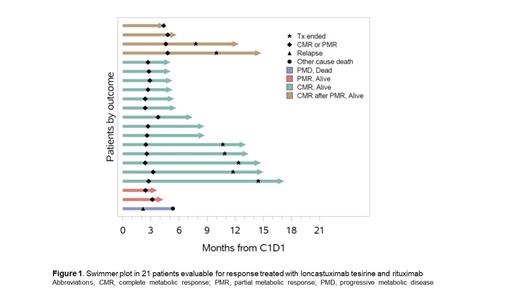Introduction: There is no standard-of-care for treatment of relapsed/refractory (rel/ref) follicular lymphoma (FL) with worse prognosis in those demonstrating progression of disease within 24 months (POD24) from frontline immunochemotherapy. Loncastuximab tesirine (loncastuximab) is an antibody-drug conjugate comprising a monoclonal antibody directed against CD19 and a DNA cross-linking pyrrolobenzodiazepine. Preclinical data demonstrated synergistic activity between rituximab-induced cytotoxicity and loncastuximab. Here we report pre-specified initial results of a single-institution investigator-initiated study evaluating this combination for the first time in FL (NCT04998669).
Methods: Adult patients with rel/ref FL previously treated with ≥1 line of systemic therapy presenting GELF criteria or POD24 at enrollment were eligible.Primary study endpoint was complete response (CR) by week 12 PET/CT based on Lugano 2014 criteria. Bone marrow biopsy was required at screening and repeated at week 12 if initial involvement. The initial 21 weeks of therapy consisted of 4 weekly doses of rituximab i.v. 375mg/m 2 followed by 1 dose every 8 weeks for a total of 5 doses in association with loncastuximab i.v. 0.15mg/kg every 3 weeks for 2 doses followed by 0.075mg/kg every 3 weeks for a total of 7 doses. Patients achieving CR by week 21 PET/CT discontinued loncastuximab and received two more doses of rituximab every 8 weeks. Premedication with dexamethasone 4 mg twice daily for 3 days was required with loncastuximab. No antibiotic or growth factor prophylaxis was mandated by study protocol. Enrollment occurred according to a Simon's minimax two-stage design with a total sample size of 39 patients based upon a projected CR rate ≥50% vs ≤30% (H0), type I error alpha 5%, power 80%. In stage 1, 19 patients enrolled and 7 or more CRs were required to proceed with stage II. In stage II, an additional 20 patients will be enrolled. Based on n=39, a total of ≥17 CRs are required for rejecting the H0.
Results: Twenty-six patients have been enrolled from January 2022 to July 2023, 25 evaluable for toxicity (1 patient has not yet initiated treatment) and 21 for response. Median age was 68 years (range 47 to 89). Most were women (n=14; 54%), with advanced-stage (n=20; 77%), high-risk FLIPI score (n=13; 50%), and 12 (46%) demonstrating POD24 after immunochemotherapy. Median lines of prior therapy were 1 (range 1 to 6). R-CHOP was most common first-line therapy (n=14; 54%) followed by bendamustine with rituximab and single-agent rituximab (n=6; 23%; each).
Most common grade 1 adverse events (AEs) included alkaline-phosphatase (48%), ALT (44%), AST (36%) elevation; maculo-papular rash (44%), fatigue (28%), thrombocytopenia (28%), photosensitivity (28%), leg edema (24%), and anasarca (20%). Grade 2 AEs were alkaline phosphatase elevation (12%), anasarca (8%) and leg edema (4%) Grade 3 AEs included neutropenia (n=2; 8%), and one case each (4%) of cellulitis and pleural effusion. Neutropenia was the only grade 4 AE in a patient post-CAR T-cell. All toxicities resolved with supportive management and dose delays (n= 4); no treatment-related deaths occurred during study period.
CR was observed in 7 of the initial 10 patients meeting pre-specified criteria to proceed to stage II. Among 21 patients evaluable for response, the overall response rate at week 12 was 95.2% [CR rate of 66.7% (n=14), partial response (PR) rate of 28.6% (n=6)]. All CR were maintained and 4 of the 6 PR (2 patient have not yet re-evaluated) improved to CR at week 21 for a best CR rate of 86% (n= 18). Baseline bone marrow involvement by FL resolved in all patients (n=5) at week 12 reassessment. Two patients were removed from the study. One patient due to disease progression on week 12 PET/CT with biopsy-proven diffuse large B-cell lymphoma in a kidney mass and another with cholangiocarcinoma, who achieved CR with respect to known lymphoma involvement. Both lesions were present before study enrollment but radiologically considered FL. All seven patients who completed the study remained in CR after end of treatment for a median follow up of 4.8 months (range 3.2 to 6.7) ( Figure 1). Updated analysis will be presented at the meeting.
Conclusion: A limited duration program combining loncastuximab with rituximab in patients with rel/ref FL is well tolerated and highly effective with a metabolic CR rate of 86% including high-risk patients with POD24 and/or high disease burden.
Disclosures
Alderuccio:Genmab: Research Funding; Abbvie: Consultancy; ADC Therapeutics: Consultancy, Research Funding; Genentech: Consultancy. Alencar:Dr Reddy: Honoraria; Lilly: Membership on an entity's Board of Directors or advisory committees; Janssen: Membership on an entity's Board of Directors or advisory committees; TG Therapeutics: Membership on an entity's Board of Directors or advisory committees; Incyte: Membership on an entity's Board of Directors or advisory committees; Amgen: Membership on an entity's Board of Directors or advisory committees; Beigene: Membership on an entity's Board of Directors or advisory committees; SeaGen: Membership on an entity's Board of Directors or advisory committees; Epizyme: Membership on an entity's Board of Directors or advisory committees; Genentech: Membership on an entity's Board of Directors or advisory committees. Spiegel:ImmPact Bio: Consultancy; Kite Gilead: Consultancy. Sandoval-Sus:BeiGene: Other: Ad Board; Genentech: Other: Ad Board; Abbvie: Other: Ad Board; Genmab: Other: Advisory Board; Janssen: Other: Advisory Board; Seagen: Other: Advisory Board, Speakers Bureau; ADC Therapeutics: Other: Advisory Board; Incyte: Other: Advisory Board; MassiveBio: Other: Advisory Board; TG Therapeutics: Other: Advisory Board. Beitinjaneh:Kite: Honoraria. Lossos:LRF: Membership on an entity's Board of Directors or advisory committees; Adaptive: Honoraria; University of Miami: Current Employment; NCI: Research Funding; NCI: Research Funding; BeiGene: Consultancy. Rosenblatt:Synergys: Other; University of Miami Miller School of Medicine: Patents & Royalties: Intellectual property; Biograph 55: Research Funding.


